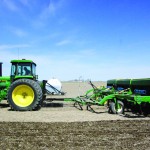
Features
Unique marketing plan
Control soybean aphids
Soybean aphids aren’t an annual problem in Manitoba, but lessons from Ontario may be helpful on your farm
Over 2.6 million acres of soybeans were grown in Ontario in 2012, making them Ontario largest row crop,” said Horst Bohner, Soybean Specialist, Crop Technology Branch, Ontario Ministry of Agriculture, Food and Rural Affairs (OMAFRA). “As soybeans are considered a warm-season crop and were originally a sub-tropical plant, the length of their growing season is […] Read moreWide range of seed weights
Before you set your seeding rates, look at these relationships between seeding rate, seed size and seedling survival
Editor’s note: In last week’s “Grainews,” an article on thousand kernel weight went through the math of using seed weights to calculate seeding rates. This article from the Canola Council shows the relationships between seed size, seed rates and seedling survival in canola. Thousand kernel weight (TKW) for canola seed can vary from less than […] Read moreCrop advisor’s Casebook
Seed-placed phosphorus for canola and soybeans
Seed-placed phosphorus can give plants an extra boost early in the season, but it’s important to think about your entire rotation
Seed-placed fertilizers give plants that extra boost early in the season and are especially useful to provide the phosphorus that plants need right from the get go. But with the introduction of new crops like soybeans into Prairie rotations, seed-placing phosphorus has become more complex. Soybeans and canola are both highly sensitive to seed-placed fertilizers. […] Read more
Liquid fertilizer and melting urea
Patrick Fabian found a new way to stretch his fertilizer dollar further and take his fertility management to the next level
Producing drought-resistant crops
Growing deep-rooted prairie plants can create soil with better drainage and a better ability to provide plant-available water
Reconstructed native prairies may offer an ideal crop for biofuel feedstock. Prairie plants could be grown alone or in rotation with row crops — allowing farmers to enjoy the benefits of either system. Deep-rooted prairie plants create healthier soil, rich in organic matter, with plenty of aeration, good infiltration, stable structure and active nutrient cycling. These organic-rich […] Read moreClimate change and your farm
In this three-part series on climate change, Angela Lovell takes a look at what our Prairie farms might look like in 30 years
This is the first in a three-part series on how climate change might impact agriculture on the Canadian Prairies. If, as climate scientists predict, Canada’s Prairie region is significantly warmer in 30 years than it is now, the farm could have a very different mix of crops and livestock, some new agronomic practices, a few […] Read more

